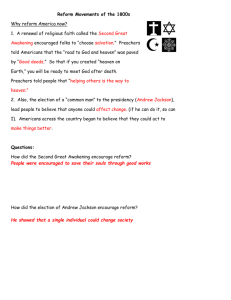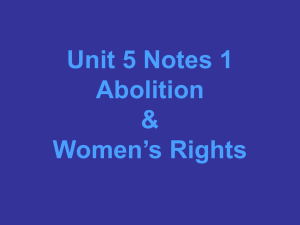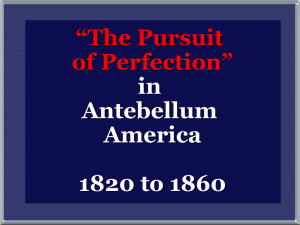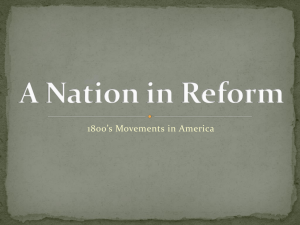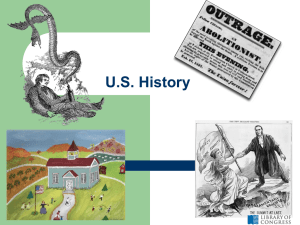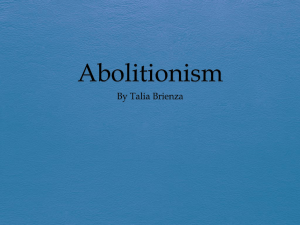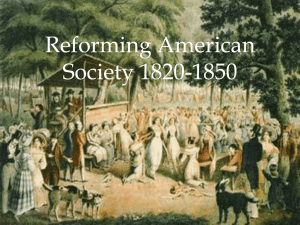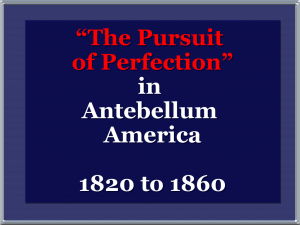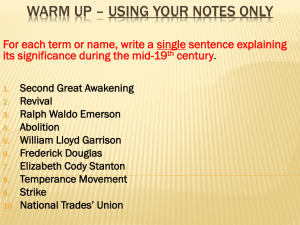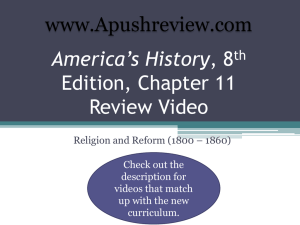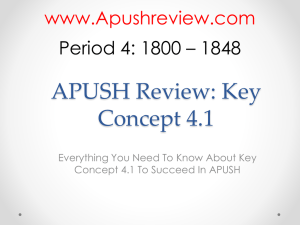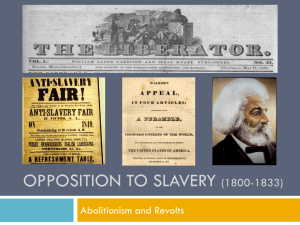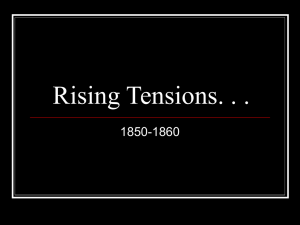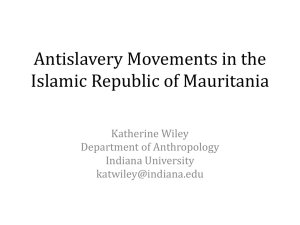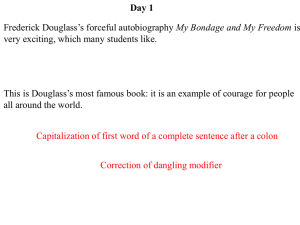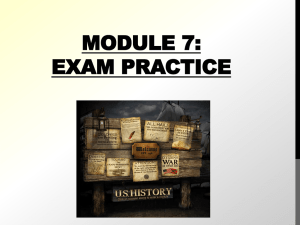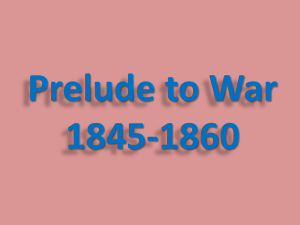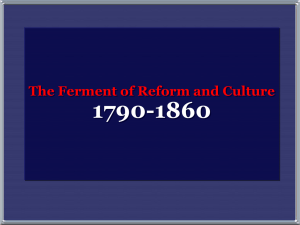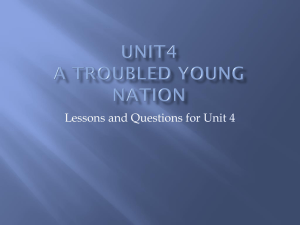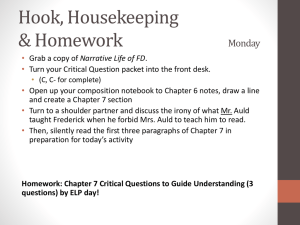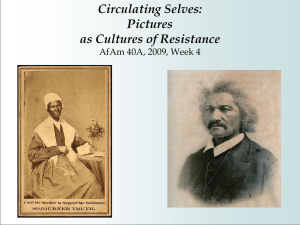Reform Movements
advertisement
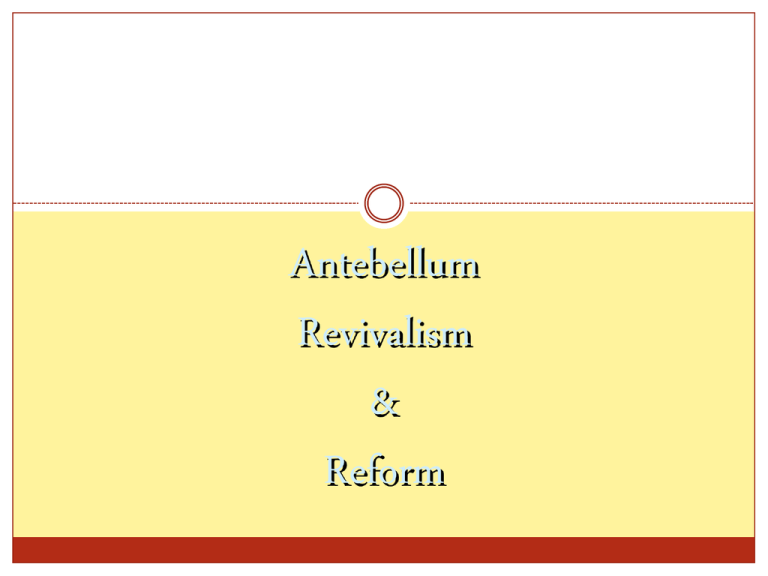
Antebellum Revivalism & Reform Social Reforms Several social reform movements began during the early-mid 1800s. These movements aimed to transform society for the better. Many who participated in these movements were inspired by the Second Great Awakening (a religious movement). Second Great Awakening Early 1800’s Started in Kentucky and Tennessee As part of the “Awakening,” evangelical Christian preachers traveled from revival to revival preaching the Gospel and calling on believers to become socially active and impact society through good works. Religion motivated many to become social reformers. Second Great Awakening Revival Meeting Stirring of Reforms Democratic principles of Second Great Awakening stirred the reform movements of the 1830s and 1840s. Reformers based arguments on Protestant principles. Led people to risk lives to help slaves escape, to face hostile crowds to demand women’s rights… The Second Great Awakening “Spiritual Reform From Within” [Religious Revivalism] Social Reforms & Redefining the Ideal of Equality Temperance Education Abolitionism Asylum & Penal Reform Women’s Rights Reform Movements: Education Western expansion impacted education. As the nation grew and people became more spread out, leaders and citizens wanted to make sure that the country had a sense of national values (individualism and patriotism). Democracy couldn’t survive without literate, informed voters and moral citizens. Edu reformers fought for tax-supported public schools. Schools promote self-discipline and good citizenship. Many believed the US must educate is population in order to compete with other nations. Many states included public education in their state constitutions. Reform Movements: Education One key leader in the education movement was Noah Webster. He compiled the 1st US dictionary that included words and spelling (in the American vernacular). Webster played a major role in forging a national language and helped the nation unify educational standards in a way that proved beneficial to the country. Horace Mann was another education reformer who wanted both men and women to have access to public education. Mann believed that education was essential to the success of democracy. He helped to create the 1st public Board of Education in Massachusetts. He inspired other states to offer public education as well. The McGuffey Eclectic Readers Used to teach American values, respect for order, 3 R’s, Protestant ethic – frugality, hard work, sobriety! Reform Movements: Temperance Temperance Movement: Organized campaign to moderate or end alcohol consumption. Saw alcohol as threat to self-control and self-discipline, threat to family life. The temperance movement owed much of its success to women and church leaders in the US. Alcohol is not actually banned nationwide until Prohibition begins in 1920, but the movement to prohibit alcohol began in 1820. 5. Temperance Movement 1826 - American Temperance Society “Demon Rum”! Frances Willard R1-6 The Beecher Family Annual Consumption of Alcohol “The Drunkard’s Progress” From the first glass to the grave, 1846 Anti-Slavery Alphabet Reform Movements: Abolitionist The abolitionist movement, the movement to end slavery, gained momentum in the 1830s. As dependence on slave labor increased in the South, opposition to slavery increased in the North. White members of the abolition movement were mostly middle class, educated, church people from New England (many Quakers). Black abolitionists were mostly former slaves, such as Frederick Douglass. Prominent White Abolitionists While some sought to merely limit slavery’s expansion into new territories, others were determined to end it completely. Those who advocated the total abolishment of slavery were called abolitionists. Key white figures in this movement included William Lloyd Garrison and the Grimke sisters. William Lloyd Garrison founded an influential anti-slavery newspaper called The Liberator, and helped establish the American Anti-Slavery Society. Sarah and Angelina Grimke were members of a prominent slaveholding family in SC who became abolitionists and won national acclaim for their passionate anti-slavery speeches. Women played a key role in the abolition movement. Other white abolitionists included Harriet Beecher Stowe (Uncle Tom’s Cabin), and Henry David Thoreau (transcendentalist). William Lloyd Garrison (1801-1879) Slavery & Masonry undermined republican values. Immediate emancipation with NO compensation. Slavery was a moral, not an economic issue. R2-4 The Liberator Premiere issue January 1, 1831 R2-5 Frederick Douglass Early Years Frederick Douglass was born into slavery in Maryland in 1817. Although Maryland state law prevented the education of slaves, Douglass was taught first by his owner’s wife and later educated himself. As a field hand, Douglass was brutally beaten, reaching what he called a “turning point” in his life–the time that he fought back. In 1838, Douglass disguised himself as a sailor and escaped to New Bedford, Massachusetts. Douglass as Activist Douglass became a writer and speaker for the abolitionist movement, earning a reputation for passion and eloquence. Douglass founded an abolitionist newspaper, the North Star, in 1847. To avoid capture by his former master, Douglass went to Europe, where he raised the money to purchase his freedom. Douglass believed that slavery should be fought with deeds as well as words, although without violence. Frederick Douglass (1817-1895) 1845 The Narrative of the Life Of Frederick Douglass 1847 “The North Star” R2-12 The Underground Railroad Thousands of slaves escaped to freedom via the Underground Railroad, a secret network of abolitionists who guided and sheltered fleeing slaves along paths which led to northern states or Canada. The Underground Railroad consisted of numerous paths whose natural characteristics helped escaping slaves avoid their pursuers. These included the Mississippi and Ohio rivers, the swamps along the East Coast, and the Appalachian Mountains. One famous Underground Railroad “conductor,” Harriet Tubman, was herself an escaped slave. After escaping to the North, she made many trips back to the South, helping more than 300 other slaves to freedom. Some people, including the Quakers of southern Ohio, were sympathetic to the Underground Railroad. Others, including whites in southern Illinois, attempted to catch escaped slaves as they fled. Harriet Tubman (1820-1913) Helped over 300 slaves to freedom. $40,000 bounty on her head. Served as a Union spy during the Civil War. “Moses” Sojourner Truth (1787-1883) or Isabella Baumfree 1850 The Narrative of Sojourner Truth R2-10 Leading Escaping Slaves Along the Underground Railroad The Underground Railroad The Underground Railroad “Conductor” ==== leader of the escape “Passengers” ==== escaping slaves “Tracks” ==== routes “Trains” ==== farm wagons transporting the escaping slaves “Depots” ==== safe houses to rest/sleep Resistance to Abolitionism Opposition in the North Even in the North, abolitionism was viewed as a radical idea in the decades before the Civil War. Northern merchants feared that tensions with the South over slavery would hurt trade, and labor leaders feared that escaped slaves would take jobs away from white Americans. Opposition to abolitionism became violent. Meeting halls and printing presses were destroyed, and abolitionists were humiliated and killed. Opposition in the South Most white southerners were outraged by abolitionists’ criticisms. During the 1830s, speaking out against slavery became increasingly dangerous and rare in the South. In 1836, southerners in Congress passed what northerners called the gag rule, which prohibited antislavery petitions from being read or acted upon in the House for the next eight years. The Antislavery Movement—Assessment What was the purpose of the Underground Railroad? (A) To provide political action to change slavery laws (B) To help fleeing slaves escape to freedom (C) To give women a voice in the abolitionist movement (D) To stop the abolitionist movement by violent means What was one reason that some northerners were opposed to abolitionism? (A) They were outraged by abolitionists’ criticisms. (B) They feared that tensions would hurt trade with the South. (C) They felt that speaking up against slavery was too dangerous. (D) They were disappointed with how African Americans in the movement were treated. The Antislavery Movement—Assessment What was the purpose of the Underground Railroad? (A) To provide political action to change slavery laws (B) To help fleeing slaves escape to freedom (C) To give women a voice in the abolitionist movement (D) To stop the abolitionist movement by violent means What was one reason that some northerners were opposed to abolitionism? (A) They were outraged by abolitionists’ criticisms. (B) They feared that tensions would hurt trade with the South. (C) They felt that speaking up against slavery was too dangerous. (D) They were disappointed with how African Americans in the movement were treated. Reform Movements: Women’s Rights Chapter 9, Section 3 Fighting for Reform For many women, participating in the reform movements of the late 1800s was a first taste of life outside the home. Women participated in many aspects of reform, including writing, speaking, and marching in parades to support their cause. Through these activities, many middleclass women became aware both of their inferior position in society and of their ability to fight to change it. Fighting for Abolition Many women entered the public world of politics by participating in the fight to end slavery. Women saw parallels between their status and that of African Americans. Some men objected to women’s participation in the abolitionist movement, believing that women should use their influence only within their families. Reform Movements: Women’s Rights Women played a key role in the abolitionist and temperance movements, only to face discrimination from the men whom they’d served. This led to the birth of the Women’s Rights Movement. Elizabeth Cady Stanton helped organize the 1st women’s rights convention, known as the Seneca Falls Conference, in 1848, where she called for women’s suffrage. Susan B. Anthony joined Stanton to fight for women’s rights. With Stanton, she fought for suffrage until her death in 1906. Neither saw the fruits of their labor. Women did not get the right to vote until 1920, after both died Cult of Domesticity = Slavery The 2nd Great Awakening inspired women to improve society. Angelina Grimké Sarah Grimké Southern Abolitionists R2-9 Lucy Stone American Women’s Suffrage Assoc. edited Woman’s Journal 8. Women’s Rights R2-6/7 1840 split in the abolitionist movement over women’s role in it. London World Anti-Slavery Convention Lucretia Mott 1848 Elizabeth Cady Stanton Seneca Falls Declaration of Sentiments Assessment What was significant about the Seneca Falls Convention? Elizabeth Cady Stanton is most identified with: Jacksonian Democracy Education reform Abolition Women’s suffrage 4. Penitentiary Reform Dorothea Dix (1802-1887) 1821 first penitentiary founded in Auburn, NY R1-5/7 Dorothea Dix Asylum - 1849 Reform Movements Using the manila folder I gave you, create a brochure to promote the goals of one of the 1800s reform movements you have learned about: temperance, education, abolition, or women’s rights. In your brochure, you should address the goal of the movement, important leaders in the movement and their contributions, grievances, advances achieved, and conditions before reform. Make it neat, and include relevant visuals.
